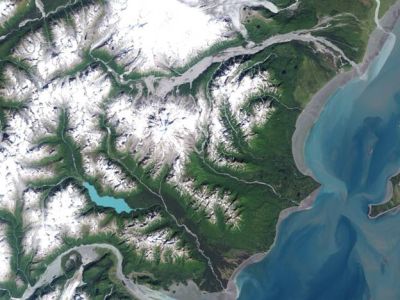11 February 2009

NASA image created by Jesse Allen, using Landsat data provided by the United States Geological Survey. Caption by Holli Riebeek with input provided by Jefferson Beck, Earth Science Video Producer at NASA Goddard Space Flight Center.
NASA recently published an exquisite satellite image of a giant Alaskan volcano, known as Redoubt Volcano. This volcano last erupted in 1989, and it has been rumbling since late January 2009. The volcano would probably erupt within days.
The snow-covered Redoubt Volcano is over 3,000 m in height. It is one of many volcanoes that line Alaska’s southern shores. Redoubt is also one of the most active of the Cook Inlet volcanoes. During its 1989-90 eruption, the volcano sent a huge plume of volcanic ash that threatened air traffic.
According to the Alaska Volcano Observatory (AVO), quakes started to shake Redoubt, most likely due to magma (molten rock) rising in the volcano. Based on Redoubt’s history of activity, the AVO expected a small to moderate eruption, or the volcano could quiet without an eruption.
This image, taken by the Landsat satellite on 16 August 2000, reveals some of the potential hazards associated with an eruption. When hot gases and lava erupt from the volcano, the snow will melt, possibly sending floods of water and debris down the mountain. These volcanic floods are termed lahars, and a lahar from Redoubt would likely stream down the Drift River, which drains the volcano on the north. The volcanic flood could reach Cook Inlet, to the right of image. Such flooding on the Drift River is not unprecedented.
Lahars may also leave a permanent feature on the landscape. About 3,500 years ago, a large lahar, thick with clay, and an avalanche of volcanic debris clogged the Crescent River to form Lake Crescent, the pale blue area southwest of the volcano.
The Alaska Volcano Observatory did not predict a lahar or eruption large enough to cause the type of change that formed Lake Crescent. Redoubt’s activity continues, while the world is watching to see what kind of eruption, if any, will occur.
References
NASA Earth Observatory
http://earthobservatory.nasa.gov/IOTD/view.php?id=36991
Aymen Mohamed Ibrahem
Senior Astronomy Specialist